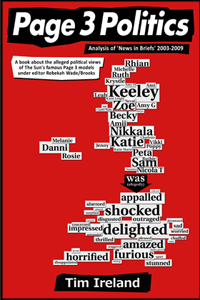This entry was posted on
Thursday, April 11th, 2002 at
12:27 pm and is filed
under Search Engine Optimisation.
In my book, The Net-Works Guide to Marketing Your Website, I took the following position on paid inclusion:
Should You Pay for a Search Engine or Directory Listing?
“No. If a search engine, directory or other site requires payment before they list you, look elsewhere. Even large search engines that charge a fee for listing are not worth your time, especially when there are so many ‘free’ search engines that are far more popular with web users.”
Times and circumstances have changed considerably since I wrote this, so I thought it might be best to clarify one or two points on the issue and indulge in a minor rant in the process.
In the last year especially, more and more search engines have started offering different models of paid entry. Yahoo! recently used their strong market position to not only adopt a compulsory paid inclusion model for any kind of business listing, but also set it up as an annual fee (more on this in a moment). Google has adopted the GoTo system (which seems to have annoyed the original creators, Overture, somewhat). With this system, known as paid placement, you pay for advertising-style placement at or near the top for keywords that you nominate. Google, of course, supplies all the back-up data for Yahoo! – who, on top of the paid inclusion method we just mentioned, have also formally teamed up with Overture to include this same model of paid placement.
It’s already looking messy, and so far we’ve only looked at three databases! So, to avoid making your head hurt and to keep things on a even keel, let’s talk about this is general terms for a short while, m’kay?
Not too long ago, most commercial sites that wanted to get your attention did so via banner ads. Why? Well, most of the marketing bods who were in charge of this kind of thing came from a traditional background. They understood the principles of paid media placement, and were comfortable with it. Blinded by stats quoting ‘millions of hits’, it took them a while to wake up to the fact that the average click-through rate for a banner campaign was somewhere around 1-5%. Some optimistic folks justified this low percentage rate with the theory that this 1-5% represented better potential customers, in that they had already been partially ‘sold’ by the ad. Others saw it to be a problem but thought that the difficulty lay in the shape or position of the banners, which I personally considered to be more than a little amusing. Do you remember the advent of the ‘skyscraper’ banner? Have you noticed how many ads are being thrown in your face via all manner of technical wizardry and interactivity?
Steve Jones of ABCnews was recently quoted as saying; “Any kind of ad that’s technically available is something we’ll consider running,” before hastily adding, “provided it doesn’t diminish the quality of ABCNews.com.”
These people are still fighting a losing battle – but many of those that did become aware of the importance of search engine optimisation did so too late – and got the wrong end of the stick in the process. Because paid placement is so prevalent these days, it’s reached the point where many SEO engineers feel it necessary to include consultation on paid placement as part of their service.
It also has to be noted that search engines and directories are under a lot of pressure from various regulatory bodies to maintain the integrity of their databases by making it very clear what is an ad and what is an actual search result – not that web users don’t know the difference already. Average click-through rates for these kinds of ads are estimated to be somewhere around, you guessed it, 1-5%. (Though it must be noted, in the spirit of fairness, that Google is trying to do the right thing in respects by offering a function that discontinues ads performing below 1% – erm, and then helpfully encourages the advertiser to take out a new ad with new wording in the hope that this will be more effective.)
Now, as the Overture model only has you paying for the traffic you receive, many people are happy with this situation – but you can see what’s happened, can’t you? Despite the illusion that this is some form of search engine optimisation exercise, it is in fact a clear and set model of paid media placement. Well, I suppose if they understand it and feel comfortable with it, the trend will continue in one form or another – but it’s this current trend that we’re talking about today, and I want to highlight a few of the negatives for you.
Some Negative Aspects of Paid Inclusion
We’ll get onto to Yahoo! soon, but first I want to tackle the issue of niche databases. Many of these are run by guys who knock together a so-called directory or search engine on a specific subject or business sector (usually by recycling someone else’s database). They will then, more often than not, email everybody they have in their new database with a message outlining how much they will have to pay for an enhanced listing, or even just to stay in the database. We enter two very, very grey areas here:
1. This kind of activity borders on unsolicited invoicing (an illegal practice in most countries).
2. It’s also borderline Spam, which they justify by wording the initial greeting as a request to have the webmaster’s ‘permission’ to list the site before, of course, swiftly moving onto the matter of payment.
With these directories, I stand by my original statement on this matter. It’s simply not worth paying to be in some two-bit directory that some idiot knocked together in his basement. But what about Yahoo!?
We’re talking about the most popular directory on the planet here, and with many of my clients I simply don’t have a choice in this matter. Because this listing is so vital in terms of basic SEO strategy, the payment has to be made. This year, and the next, and the next after that. With this we come to what I see being the biggest problem that’s going to develop in this arena unless somebody keeps a bloody close eye on it.
In my young and carefree days, I rode out the late 80’s recession as a DJ. The company I started out with ran a 1/4-page ad in the Yellow Pages and had the prime spot on the top right of the first page for mobile discos. The cost of this was somewhere in the mid 5-figure range – and seemed to go up every year. However, the poor guy who ran the company had to keep forking out year by year for fear of losing his prime spot. He also felt the need to massage whoever was top of the sales team at the time with calls and gifts, just in case they accidentally ‘lost’ his annual submission and somebody else got this top spot. He only gave up the game after it finally became economically unsustainable. Yellow Pages had him over a barrel, and he was all but forced to abandon his business as a result. This kind of crap does not make for a healthy economy.
In my less young and far less carefree days in TV advertising, I also became acquainted with one of their former salesmen who had moved into TV media sales. He told me many a tale of businesses that he had over that same barrel and the joys of commission and contra. He was, and I’m sure I can say this without offending the man, a right bastard – and therefore one of their top sales people. I’m pretty sure that, if the current situation with online directories is left unchecked, that the same will soon be said of salesmen for these top listings online, calling and emailing you from a number of different core directories with all the charm of double-glazing salesmen and with a frequency that will make you yearn for the good old days of recruitment company cold callers.
Some Negative Aspects of Paid Placement
Paid placement is advertising, pure and simple. People know what advertising is. That’s why the click-through rates are as low as they are/were for banner ads, but this is by no means the worst aspect of this kind of service.
With your typical paid placement model, you pay to be highly placed (as an ad) for search queries that you nominate. Actually, the word they use is ‘bid’, because at any time one of your competitors may choose to up the ante in order to secure the top spot ahead of you. He pays more, you pay more, he pays more, a new company comes onto the scene with a big launch budget and doubles this out of the blue – where does it end? It doesn’t. Who wins? Well, I’m sure you can guess.
The reason Google became the most popular search engine on the planet, seemingly out of nowhere, is that it included aspects in its ranking methods that improved the way that cultural forces were taken into account. Things like link popularity, link context and deeper copy indexing produced an almost supernatural ability to ferret out the best results first time, every time. Of course, a lot of SEO engineers know how to create some of these effects artificially, but Google is still one of the last places you can search for something and pretty much get the best result, based on how good the offering is and how many people believe in it – which is why I’m so surprised that they’ve gone all-out on this paid placement model. It seems to go against everything Google is supposed to stand for.
A few weeks ago, a colleague noticed an interesting ad that came up for the search query ‘child safe chat rooms‘. The top-placed ad served up to many countries had the headline text ‘SEXY CHAT & WEBCAM ROOMS’. Despite at least two formal complaints that I’m aware of, the ad still appears (albeit somewhat lower down these days – last time I looked, two other companies had outbid this advertiser).
The first thing most people point out when they see this result is that it appears to be an understandable anomaly, in that the ad is also served up for the search query ‘chat rooms’, so appears to be ignoring the words ‘child safe’ – but shouldn’t there be some form of control mechanism to stop this kind of thing from happening? Especially considering that Google has such an excellent history of removing or controlling undesirable anomalies from its general database. Why should paid listings be any different? Gosh, do you think that maybe it has something to do with money…?
Paying For Search Engine Optimisation Services
Given that I earn a living optimising sites to achieve ‘natural’ results, I really have to address this issue here or the whole article is going to come across as being somewhat hypocritical. How is paying to have your site perform better in search engines and directories different from paying the directory or search engine directly just to get the top spot?
Well, typically, things like basic keyword arming can only go so far. While you can format a page in such a way that gets you the top spot for any given search query in some search engines, in databases like Google this becomes somewhat problematic if nobody else links to your site. Establishing link partnerships (for large sites at least), costs money. Even going out and creating a bunch of fake personal sites that link to the core URL is expensive (don’t laugh – I’ve seen this done before). You can even produce multiple doorways that see you turn up for all manner of largely unrelated search queries, but this tends to piss people off more than anything.
Funnily enough, the best bet for a site that has to fight this battle is the creation of a resource (or even some form of entertainment) that gets people to link to them – and gravitate to them – naturally. This borders on viral marketing, but I don’t tend to point it out too often, as this widely misunderstood term tends to confuse some clients.
Basically, I’ve always believed that for a site to perform well in search engines – and do so consistently – it needs to offer something of value and build a relationship on this. Paid placement bypasses the need for this value.
In Summary
Look, there are lots of things that make this kind of business necessary from the point of view of the search engines and directories (after all, the money has to come from somewhere), but I still don’t believe that it’s a good thing for the average web user or site promoter.
You see a girl. Your eyes meet, there’s a moment of magic that passes between you. You ask her out, she accepts. You take her out for drinks and a meal. Discussion reveals many common interests. If all goes well, maybe afterwards you’ll go back to her place for coffee and, one would hope, the creation of the mythical hot and sweaty double-backed beast.
Of course, for the same amount of money you could just go out and have cold and impersonal sex with a prostitute. Hell, with what dinner and drinks costs these days, you could probably afford to go twice – but, despite the outlay being more or less the same, the nature of these two encounters is very, very different. Which, for example, do you think is going to be the more intimate and enriching experience for both parties? Which do you think might realistically lead to future relationship? When it gets down to it, which do you think is simply going to be the better quality shag?
Exactly.



